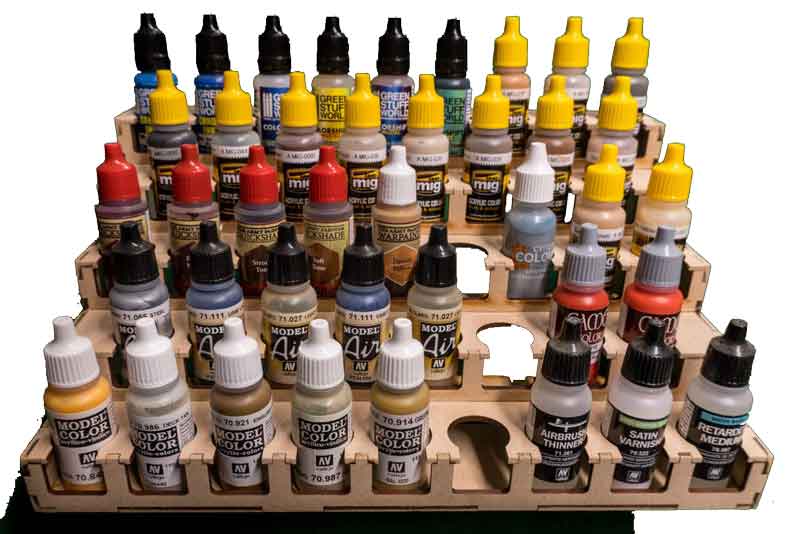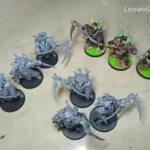Which paint Can you use on plastic models | tested

After spending countless hours building your model kit and getting all the details in the right places, adding some colorful paintings can spruce up your model’s overall appearance.
Still, imagine spending hours on your model only to select a paint that leaves you disappointed in the finished work.
Painting your model is no doubt, the most time-consuming part of scale modeling. But, you will feel quite accomplished when you choose the right paint.
If you’ve got a plastic model, you need to use paints that will leave a durable finish and dries with saturated color.
What paint can I use on plastic models?
Acrylic and enamel paints are the best two options to paint your plastic models. But, these paints are uniquely different from each other to a great extent when considering their usage, drying properties, and finish.
- Acrylic Paints
Acrylic paints are usually recommended for beginners because they are water-based, easy to work with, dry out quickly, and can be thinned easily with a water mixture.
Another advantage of acrylic paints is that they don’t have a strong smell making them convenient for use in air-restricted areas or even around kids*.
- Enamel Paints
Unlike acrylic paints, enamel paints are oil-based and provide better color coverage with a smoother finish. Also, enamel paints are easy to manipulate even after they dry.
The only drawback of this paint is that due to their pliable nature even after they’ve dried, they cure slowly.
Their turpentine base means they also have slightly strong fumes. Plus, they do not allow water mixture since enamel paints are oil base will react.
Instead, manufacturers design special enamel thinners so that model builders can easily mix the enamel paint.
Enamel will be the best paint for plastic models
For most model builders, acrylic paint is the best for their plastic models because they are easy to touch up if it ever fades or smears, allow a water-cleaning technique if you ever spill it, and are easy to thin with water mixture.
However, this thinning property means they are not as durable as enamel paints.
If you want to attain a permanent finish that won’t easily wear away, the best paint for your plastic model would be enamel paints.
Enamel paints are durable, thicker, and will leave a stronger coat when applied.
Any enamel paint can be used for plastic models
Enamel paint works exceptionally for various models, especially plastic and metals.
Their oil-base form means they are more hard-wearing, are durable and will easily help you repair chipped paints on your models.
They also have a slow drying time, taking a few hours to be touch dry and up to a few days to completely cure. The slow drying time makes them easier to blend as you paint.
They also allow you time to wipe off any mistakes if you use a touch of the enamel thinner.
Which acrylic paint will work on plastic models
Any acrylic paint will work on plastic models.
For instance, if you use artistic acrylic, you will find that they are very similar to modelmakers acrylics. However, artistic paints are much thicker and translucent.
On the same note, understand that not all acrylic paints are the same, especially artistic acrylic paints. Some are decent and have thin pigments, even better than many modeling paints.
On the other hand, some are cheap and won’t work. When you get cheap acrylic colors, they will often behave like cheap paints. Don’t expect great results from generic paint made for kids to have a good result.
Can you use any acrylic paint for models?
Yes, any acrylic paint can work for any model.
Acrylic paints come in a wide variety of forms, from water-based to alcohol-based ones.
To use all types of acrylic on your model, you must learn to blend your colors to give you more saturated pigment and include much less filler if that is what you aim to achieve.
Use regular spray paint on plastic models only if you have to
If you’ve ever been in a situation where you run out of modeler paint for your plastic model and can’t find any in your local hardware store’, so you opt for regular spray paints, and regret your decision, then it simply means you failed to prepare your model.
Many modelers believe regular paints work the same as modelers’ paint, so everything should be fine when they use it, but this is not so.
Of course, regular paints can be used on plastic models, but only with preparation.
You need to first add a thorough coat of protective primer between the paint and the plastic to guard your carefully prepared bodywork.
The primer also allows applying the color coat of your choice. But, ensure that the primer-and-paint combination will be safe to apply over plastic.
If you are not sure about this, test it on an unwanted model or a piece of sheet styrene before using them on your model.
Krylon spray paint can be used on plastic models only if you prime it first
If you’ve ever gotten a Krylon spray paint, you must have noticed the label on the body that says they are “for plastic.”
The fact is that many Krylon sprays don’t work well on plastic.
When used on your plastic model, they either melt or fade the plastic, giving it a wrinkled appearance. The only way to successfully use Krylon spray paints on your plastic model is by priming them with a lacquer primer before applying your Krylon spray paint.
automotive paint has a ‘hot’ solvent that can damage plastic models
Model paints gotten from hobby shops are specially formulated for plastic models. In fact, they are designed with a cool chemical composition that is harmless to delicate plastic parts.
However, automotive pigments gotten from hardware stores are quite the opposite. Many automotive paints contain “hot” solvents that can damage plastic but that does not mean you cannot use them on your plastic models.
To ensure your plastic stays in good condition after using automotive paints, you will need a primer between the paint and the plastic.
Don’t use Rustoleum paint on plastic models
Rustoleum paints are composed of very aggressive solvents that work well on metal and wood models.
However, plastic models will easily melt and chip.
So, if you’re wondering whether you can use Rustoleum paints on plastic models, the simple answer is no. Use them on about anything that is metal but never model plastic kits.
watercolor won’t work in 99% of the plastic models
Many beginner modelers often use watercolors on their plastic model kits since they share almost similar features as acrylic paints.
But, watercolors on plastic models are never a good option.
Plastic models are hydrophobic and not absorbent. Watercolor paint works on paper because the water carries the pigment into and onto the paper.
However, unlike acrylic paints, watercolors are usually super thin, making the plastic repel their water-based solution.
In essence, when you use watercolors, they do not sink into the plastic, resulting in the paint flaking off your model sooner or later.
oil paint on plastic models is great
Like enamel paints, oil paints work on plastic models. However, they can take ages to dry. They also tend to hold brush marks, especially if they are too thick.
The thick nature of oil paints means they are best for figure painting.
If you plan on using oil paints on your next plastic model, make sure to test out an unwanted plastic model so that you can easily get a new paint if the results don’t meet your expectations.
‘model paint’ is a special paint for models and it will work the best
One reason some scale modelers find it challenging to choose a good paint type for their model kits is because of the naming conventions.
If you’ve been confused for the longest time about the word “model paints,” you need to understand that they are not just about paints from a specific brand.
Model paints or modeling paints are special paints used to beautify our miniature models, and they come in different types and thickness to suit the material used in their production.
Some examples of model paints are enamel paints, acrylic paints, spray paints, and oil paints.
Conclusion
So, can you use any paint on plastic models? Whether you love acrylic, enamel, Krylon, watercolor, spray, or regular or automotive paints, they are great for model kits.
Acrylic and enamel paints are two of the best choices you want to consider for your plastic model.
Oil paints, regular paints, automotive paints, and Krylon paints will also work well for your plastic model. But, you should prepare your model by applying a proactive primer to keep your plastic from damaging.
On the other hand, watercolors are never a good option for plastic models since they are thin and won’t sip into the plastic.
Read more:
7 Best gloss coat for models (metal, Plastic, Wood)
How do you make model paint shiny?





